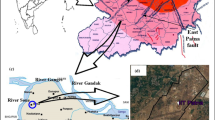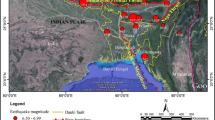Abstract
The current study looks at measuring soil’s liquefaction potential using various indexes such as the factor of safety (FOS), the liquefaction severity index (LSI), and the liquefaction potential index (LPI). The liquefaction analysis is performed on a dataset of 834 locations that contains standard penetration test values at different depths below the ground level. While the FOS-based method of liquefaction analysis investigates the possibility of liquefaction for intermediate depths, the other two methods estimate the same for the entire soil deposit. Liquefaction analysis was performed using seven different input parameters, including corrected standard penetration test blow count “N” values, fine content, maximum horizontal acceleration, total vertical stress, total effective stress, magnitude moment, and depth below ground level. To assess the capability of the proposed methods in the liquefaction potential prediction, a number of performance parameters and error matrices have been used. The effectiveness of the methodologies offered is contrasted in terms of performance factors and error matrices and the percentage of correctly predicted liquefied and non-liquefied situations. In comparison to LSI and LPI methods, the FOS-based method is found to be more accurate in the prediction of the probability of liquefaction.




Similar content being viewed by others
Data Availability
The datasets used and analyzed during the current study will be made available from the corresponding author on reasonable request.
Abbreviations
- SPT:
-
Standard penetration test
- CRR:
-
Cyclic resistance ratio
- CSR:
-
Cyclic stress ratio
- FOS:
-
Factor of safety against liquefaction
- FC:
-
Fine Content
- TN:
-
True negative (no.)
- TP:
-
True positive (no.)
- FN:
-
False negative (no.)
- FP:
-
False positive (no.)
- TPR:
-
True positive rate
- TNR:
-
True negative rate
- MSF:
-
Magnitude scaling factor
- FNR:
-
False Negative Rate
- PPV:
-
Positive Predictive Value
- NPV:
-
Negative Predictive Value
- FPR:
-
False Positive Rate
- FDR:
-
False Discovery Rate
- FOR:
-
False Omission Rate
- MCC:
-
Matthews Correlation Coefficient
- COV:
-
Coefficient of variation
- z:
-
Depthm
- \({N}_{\mathrm{1,60}}\) :
-
Corrected SPT blow count
- \({}_{{\sigma }_{v}}\) :
-
Total vertical stresskPa
- \({N}_{\mathrm{1,60},cs}\) :
-
SPT penetration resistance equivalent to clean sand
- \({\sigma }_{v}^{\mathrm{^{\prime}}}\) :
-
Effective vertical stresskPa
- \({a}_{max}\) :
-
Peak horizontal ground acceleration \({\mathrm{ms}}^{-2}\)
- \({r}_{d}\) :
-
Stress reduction factor
- \({F}_{s}\) :
-
Factor of safety against liquefaction
- \({P}_{L}\) :
-
Probability of liquefaction
References
Bolton Seed, H., Tokimatsu, K., Harder, L.F., Chung, R.M.: Influence of SPT procedures in soil liquefaction resistance evaluations. J. Geotech. Eng. 111, 1425–1445 (1985). https://doi.org/10.1061/(ASCE)0733-9410(1985)111:12(1425)
Boulanger, R.W., Idriss, I.M.: CPT and SPT based liquefaction triggering procedures. Cent. Geotech. Model. 1, 134 (2014)
Cetin, K.O., Seed, R.B., Der Kiureghian, A., Tokimatsu, K., Harder, L.F., Kayen, R.E., Moss, R.E.S.: Standard penetration test-based probabilistic and deterministic assessment of seismic soil liquefaction potential. J. Geotech. Geoenvironmental Eng. 130, 1314–1340 (2004). https://doi.org/10.1061/(asce)1090-0241(2004)130:12(1314)
Goh, A.T.C.: Neural-network modeling of CPT seismic liquefaction data. J. Geotech. Eng. 122, 70–73 (1996). https://doi.org/10.1061/(asce)0733-9410(1996)122:1(70)
Goh, A.T.C., Goh, S.H.: Support vector machines: their use in geotechnical engineering as illustrated using seismic liquefaction data. Comput. Geotech. 34, 410–421 (2007). https://doi.org/10.1016/j.compgeo.2007.06.001
Goh, A.T.C., Zhang, W.G.: An improvement to MLR model for predicting liquefaction-induced lateral spread using multivariate adaptive regression splines. Eng. Geol. 170, 1–10 (2014). https://doi.org/10.1016/j.enggeo.2013.12.003
Gutierrez, M., Duncan, J.M., Woods, C., Eddy, E.: Development of a simplified reliability-based method forliquefaction evaluation (Final Technical Report, USGS Grant No. 02HQGR0058). Virginia Polytech. Inst. State Univ. (2003)
Haldar, A., Tang, W.H.: Probabilistic evaluation of liquefaction potential. J. Geotech. Eng. Div. 105, 145–163 (1979)
Hanna, A.M., Ural, D., Saygili, G.: Neural network model for liquefaction potential in soil deposits using Turkey and Taiwan earthquake data. Soil Dyn. Earthq. Eng. 27, 521–540 (2007). https://doi.org/10.1016/j.soildyn.2006.11.001
Harr, M.E.: Reliability-Based Design in Civil. Engineering 3, 619–623 (1985). https://doi.org/10.2307/1270385
Hoang, N.D., Bui, D.T.: Predicting earthquake-induced soil liquefaction based on a hybridization of kernel Fisher discriminant analysis and a least squares support vector machine: a multi-dataset study. Bull. Eng. Geol. Environ. 77, 191–204 (2018). https://doi.org/10.1007/s10064-016-0924-0
Idriss, I.M., Boulanger, R.W.: Soil liquefaction during earthquakes. Earthq. Eng. Res. Inst. (2008)
Idriss, I.M., Boulanger, R.W.: SPT-based liquefaction triggering procedures. Davis, CA: Center for Geotechnical Modeling, Department of Civil and Environmental Engineering, University of California at Davis. Report No. UCD/CGM-10/02 (2010)
Iwasaki, T.: A practical method for assessing soil liquefaction potential based on case studies at various sites in Japan. In: Proc. Second Int. Conf. Microzonation Safer Construction Research Application, 1978. pp. 885–896 (1978)
Iwasaki, T., Tokida, K.I., Tatsuoka, F., Watanabe, S., Yasuda, S., Sato, H.: Microzonation for soil liquefaction potential using simplified methods. In: Proceedings of the 3rd international conference on microzonation, Seattle. pp. 1310–1330 (1982)
Juang, C.H., Yuan, H., Lee, D.-H., Lin, P.-S.: Simplified cone penetration test-based method for evaluating liquefaction resistance of soils. J. Geotech. Geoenviron. Eng. 129, 66–80 (2003). https://doi.org/10.1061/(asce)1090-0241(2003)129:1(66)
Juang, C.H., Jiang, T.: Assessing probabilistic methods for liquefaction potential evaluation. In: Proceedings of Sessions of Geo-Denver 2000a - Soil Dynamics and Liquefaction 2000a, GSP 107. pp. 148–162 (2000a)
Juang, C.H., Jiang, T.: Assessing probabilistic methods for liquefaction potential evaluation. Proc. Sess. Geo-Denver 2000b-Soil Dyn. Liq. 2000b, GSP 107. 295, 148–162 (2000b). https://doi.org/10.1061/40520(295)10
Kramer, S.L.: Geotechnical earthquake engineering. Pearson Education India (1996)
Kumar, D.R., Samui, P., Burman, A.: Prediction of probability of liquefaction using soft computing techniques. J. Inst. Eng. Ser. A. 103, 1195–1208 (2022). https://doi.org/10.1007/s40030-022-00683-9
Lee, C.Y., Chern, S.G.: Application of a support vector machine for liquefaction assessment. J. Mar. Sci. Technol. 21, 318–324 (2013). https://doi.org/10.6119/JMST-012-0518-3
Matthews, B.W.: Comparison of the predicted and observed secondary structure of T4 phage lysozyme. BBA - Protein Struct. 405, 442–451 (1975). https://doi.org/10.1016/0005-2795(75)90109-9
Naghizaderokni, M., Janalizade, A.: Reliability-based method for assessing liquefaction potential of soils. COMPDYN 2015 - 5th ECCOMAS Themat. Conf. Comput. Methods Struct. Dyn. Earthq. Eng. 125, 4214–4222 (2015). https://doi.org/10.1061/(asce)1090-0241(1999)125:8(684)
Naser, M.Z., Alavi, A.H.: Error metrics and performance fitness indicators for artificial intelligence and machine learning in engineering and sciences. Archit. Struct. Constr. (2021). https://doi.org/10.1007/s44150-021-00015-8
Pal, M.: Support vector machines-based modelling of seismic liquefaction potential. Int. J. Numer. Anal. Methods Geomech. 30, 983–996 (2006). https://doi.org/10.1002/nag.509
Phoon, K.K., Kulhawy, F.H.: Characterization of geotechnical variability. Can. Geotech. J. 36, 612–624 (1999). https://doi.org/10.1139/t99-038
Phule, R.R., Choudhury, D.: Seismic reliability-based analysis and GIS mapping of cyclic mobility of clayey soils of Mumbai City. India. Nat. Hazards. 85, 139–169 (2017). https://doi.org/10.1007/s11069-016-2570-z
Robertson, P.K., Campanella, R.G.: Liquefaction potential of sands using the CPT. J. Geotech. Eng. 111, 384–403 (1985). https://doi.org/10.1061/(ASCE)0733-9410(1985)111:3(384)
Samui, P.: Seismic liquefaction potential assessment by using relevance vector machine. Earthq. Eng. Eng. Vib. 6, 331–336 (2007). https://doi.org/10.1007/s11803-007-0766-7
Samui, P., Hariharan, R.: A unified classification model for modeling of seismic liquefaction potential of soil based on CPT. J. Adv. Res. 6, 587–592 (2015). https://doi.org/10.1016/j.jare.2014.02.002
Samui, P., Karthikeyan, J.: Determination of liquefaction susceptibility of soil: a Least square support vector machine approach. Int. J. Numer. Anal. Methods Geomech. 37, 1154–1161 (2013). https://doi.org/10.1002/nag.2081
Seed, H.B., Idriss, I.M.: Simplified procedure for evaluating soil liquefaction potential. ASCE J. Soil Mech. Found Div. 97, 1249–1273 (1971). https://doi.org/10.1061/jsfeaq.0001662
Sonmez, H.: Modification of the liquefaction potential index and liquefaction susceptibility mapping for a liquefaction-prone area (Inegol, Turkey). Environ. Geol. 44, 862–871 (2003). https://doi.org/10.1007/s00254-003-0831-0
Sonmez, H., Gokceoglu, C.: A liquefaction severity index suggested for engineering practice. Environ. Geol. 48, 81–91 (2005). https://doi.org/10.1007/s00254-005-1263-9
Terzaghi, K., Peck, R.B.: Soil Mechanics. Soil Mech. (1948). https://doi.org/10.1002/9781118587058
Toprak, S., Holzer, T.L., Bennett, M.J., Tinsley, J.J.: CPT-and SPT-based probabilistic assessment of liquefaction potential. In: 7th US–Japan workshop on earthquake resistant design of lifeline facilities and countermeasures against liquefaction, Seattle. p. 18. Multidisciplinary Center for Earthquake Engineering Research Buffalo, NY (1999)
Youd, T.L., Hansen, C.M., Bartlett, S.F.: Revised multilinear regression equations for prediction of lateral spread displacement. J. Geotech. Geoenvironmental Eng. 128, 1007–1017 (2002)
Youd, T.L., Idriss, I.M.: Liquefaction criteria based on statistical and probabilistic analyses. In: Technical Report NCEER-97–0022. p. 281 (1997)
Youd, T.L., Idriss, I.M.: Liquefaction resistance of soils: summary report from the 1996 NCEER and 1998 NCEER/NSF workshops on evaluation of liquefaction resistance of soils. J. Geotech. Geoenviron. Eng. 127(4), 297–313 (2001). https://doi.org/10.1061/(ASCE)1090-0241(2001)127:4(297)
Youd, T.L., Noble, S.K.: Magnitude scaling factors. In: Proc., NCEER workshop on evaluation of liquefaction resistance of soils, National Center for Earthquake Engineering Research, State University of New York at Buffalo. pp. 149–165 (1997)
Zhang, W., Goh, A.T.C.: Evaluating seismic liquefaction potential using multivariate adaptive regression splines and logistic regression. Geomech. Eng. 10, 269–284 (2016). https://doi.org/10.12989/gae.2016.10.3.269
Zhang, W., Goh, A.T.C.: Assessment of soil liquefaction based on capacity energy concept and back-propagation neural networks. Integr. Disaster Sci. Manag. Glob. Case Stud. Mitig. Recover. 41–51 (2018). https://doi.org/10.1016/B978-0-12-812056-9.00003-8
Zhang, W., Goh, A.T.C., Zhang, Y., Chen, Y., Xiao, Y.: Assessment of soil liquefaction based on capacity energy concept and multivariate adaptive regression splines. Eng. Geol. 188, 29–37 (2015). https://doi.org/10.1016/j.enggeo.2015.01.009
Acknowledgements
The authors are thankful to colleague at National Institute of Technology Patna who effectively contributed to this study.
Author information
Authors and Affiliations
Contributions
• Divesh Ranjan Kumar: conceptualization, data curation, formal analysis, investigation, methodology, resources, software, validation, visualization, and writing—original draft.
• Avijit Burman: writing—review and editing
• Pijush Samui: supervision
Corresponding author
Ethics declarations
Ethics Approval and Consent to Participate
Not applicable.
Consent for Publication
Not applicable.
Competing Interests
The authors declare no competing interests.
Additional information
Publisher's Note
Springer Nature remains neutral with regard to jurisdictional claims in published maps and institutional affiliations.
Rights and permissions
Springer Nature or its licensor (e.g. a society or other partner) holds exclusive rights to this article under a publishing agreement with the author(s) or other rightsholder(s); author self-archiving of the accepted manuscript version of this article is solely governed by the terms of such publishing agreement and applicable law.
About this article
Cite this article
Kumar, D.R., Samui, P. & Burman, A. Determination of Best Criteria for Evaluation of Liquefaction Potential of Soil. Transp. Infrastruct. Geotech. 10, 1345–1364 (2023). https://doi.org/10.1007/s40515-022-00268-w
Accepted:
Published:
Issue Date:
DOI: https://doi.org/10.1007/s40515-022-00268-w




